Quebec City Travel Guide
Perched atop Cap Diamant (Cape Diamond) and overlooking the Saint Lawrence River, Quebec City was first settled by the French in 1608 and named for a native Algonquin word meaning 'where the river narrows'. The ambience, lively spirit, high safety rating and comfortable blend of past and present make Quebec's provincial capital worthy of its place among the world's top cultural destinations.
The cradle of French civilisation in North America and still notably European in spirit, the historic Old Quebec neighbourhood has an unmistakable charm. Small cafes, cosy restaurants, classy boutiques, lively terraces, elegant squares, theatres, museums and street performers all come together in a fascinating weave of old-world allure.
Millions of visitors are drawn to Quebec City every year, savouring the famed Quebec gourmet scene and the beauty of the historic old district's winding cobbled streets, where 17th and 18th-century stone houses, churches, parks and a number of monuments still stand. The city is included on UNESCO's World Heritage List and is one of the only fortified cities in the Americas.
Despite having been ceded to the British in 1759, the city's population remains 95 percent French-speaking, lending a definite joie de vivre and French elegance to the atmosphere.
Things to do in Quebec City
Many interesting sights and tourist attractions are located in the Old Quebec district, including dozens of small shops, boutiques and attractive historical buildings. The more modern Upper Town and Lower Town also have interesting neighbourhoods.
Quebec City is compact and easily walkable. Visitors who get tired or can't navigate the steep stairs between Upper Town and Lower Town can take a scenic ride in the Funicular, or hire one of many horse-drawn carriages for a quaint mode of sightseeing.
Attractions include the National Museum of the Arts, the Franco-American Museum and the Capital Observatory, which is in one of the tallest buildings in Quebec. Visitors could also ferry across the St. Lawrence River to Lévis and enjoy memorable views of the Chateau Frontenac and the Old City. Sunset cruises on the Saint Lawrence River are a must.
Children may relish a trip to the Chocolate Museum or a spin around the Old City's ice rink, while Villages Vacances Valcartier has waterslides and go-karting in the summer. Just a few kilometres from downtown, the unspoilt wilderness areas surrounding Quebec City present plenty of opportunities for outdoor activities and recreation, such as horseback riding, canoeing, hiking and skiing.
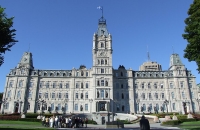
Parliament Buildings
Just outside the old city walls stands the imposing 19th-century Parliament Building, inspired by the Louvre in Paris and designed by the architect, Eugène Étienne Taché. Although it is the working home of the 125-strong National Assembly, the buildings are open to visitors for free guided tours, which are offered in English or French, and highlight the historic value of the unique building as well as inform visitors about the organisation and proceedings of the Québec National Assembly. Tours should be booked in advance for groups of 10 or more. There is a restaurant and a gift shop at the Parliament Building.
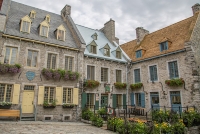
Place Royale
The Place Royale is part of the Pointe-à-Callière Museum complex, along with Pointe-à-Callière and 214 Place d'Youville. Used for trading in ancient times by the First Nations, the site of the historical Place Royale became a fortified trading post in 1608 under French colonist Samuel de Champlain. Known as the market square, the site thrived until the end of the 19th century when its importance began to decline. But it was given a new lease on life under a government restoration programme, ensuring the site known as the 'birthplace of French America' turned into one of the city's main attractions.
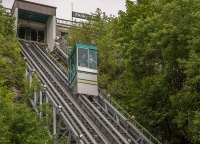
Funicular
The funicular which travels from the heart of the Old City to Dufferin Terrace provides a panoramic bird's eye view of historic Quebec City. Leaving from Louis Jolliet House, the funicular has been an attraction since the original steam version was built in 1879. Claustrophobic visitors may not enjoy the trip up in the little compartments, but most will relish the views and novel mode of transport. The walk down from the Old City is pleasant and easy, but the hike up can be rather difficult. Many visitors choose to take the funicular up and walk back down.
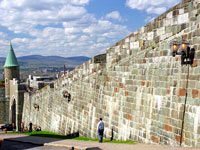
Fortifications
Guided walking tours of the three mile (5km) wall surrounding the Old City of Quebec trace the evolution of the city's defence system across three centuries. The walls were built between 1608 and 1871 as part of the fortifications in the area, which was the region's main colonial stronghold. The walls are set with interpretation panels and can be explored independently. Following the walls is a wonderful way to explore the old city and visitors will pass many interesting sights in the historic centre along the way, including the Esplanade Powder Magazine. Quebec is the only surviving fortified city in North America and has been designated a World Heritage City.
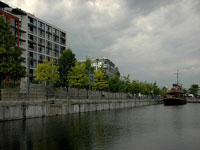
Old Port of Montreal
The Old Port of Montreal along the Saint Lawrence River is actually fairly new, having undergone a big facelift to make it the most popular tourist spot in the city. A major 19th-century trade port, its wharves now mostly consist of tour boats, ferries and amphibious buses handling its roughly five million visitors each year. Ferries cross to the Parc Jean-Drapeau, site of the Expo 67 World's Fair, which lies on the Saint Lawrence and offers facilities for picnicking, swimming, and skating and skiing in winter.
The Old Port is a thriving arts and entertainment venue where there's always something happening. It also offers a huge open-air skating rink, IMAX cinema, vibrant cafes and a Science and Technology Center. The clock tower offers excellent views, while the original 17th-century city fortifications still stand. Characters in period costume conduct guided tours through the streets and alleys, pointing out points of historic significance.
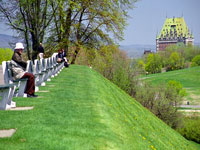
Battlefields Park (Plains of Abraham)
Once the setting for bloody battles between the British and the French, the Plains of Abraham today serve as Quebec City's primary 'green lung'. A playground and peaceful arboreal retreat, it's a venue for a variety of festivals, fairs and events. The park is to Quebec what Central Park is to New York, covering 108 hectares and containing 6,000 trees, monuments and interpretive centres. In winter, both locals and visitors enjoy a giant skating rink and a few fun ski tracks in the park. Summertime is ideal for jogging, rollerblading or strolling in the fragrant gardens, or picnicking in its leafy shade.
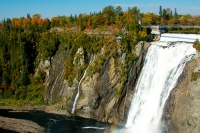
Montmorency Falls Park
Just to the east of Quebec City lies the spectacular Montmorency Falls which plunges 272 feet (83m) â€' one and a half times higher than Niagara Falls. Besides a beautiful setting, the park also boasts historic buildings and a variety of fun activities. A cable car runs up to the historic Manoir Montmorency manor, which was built in 1781, and which contains a restaurant, viewing terrace, interpretation centre, reception rooms and boutiques. A suspension bridge hangs directly across the falls, providing a breathtaking vista, while a second bridge gives access to the east side of the falls where there are numerous viewpoints and trails.
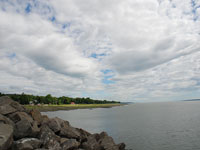
L'Île d'Orléans
The little island in the Saint Lawrence River, just 15 minutes from downtown Quebec City, is a historical treasure trove containing 600 heritage buildings. Algonquin natives called the island Windigo, meaning 'bewitched corner', before French colonists arrived in 1535 and named it for the Duke of Orleans. The island is the ancestral home of more than 300 Quebecois families and still has more than 7,000 inhabitants. A perimeter road called the Royal Way connects all the six villages on the island, extending across the Taschereau Bridge to the mainland. Visitors enjoy cycling or driving around the island to marvel at panoramic views of the river and explore sites such as the oldest church in New France.
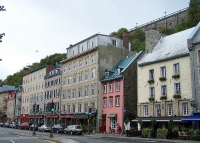
Lower Town (Basse-Ville)
Basse-Ville is Quebec City's charming old quarter, full of narrow winding streets, historical stone buildings and a dizzying array of trendy cafes, bars and boutiques. Also called Lower Town, it's the oldest urban district in Canada and exudes a distinctly European atmosphere. Recent gentrification of more dilapidated areas has resulted in postcard-perfect photo opportunities waiting on every corner. Lower Town is also home to many of the city's most celebrated sights and attractions, including the Place Royale, Petit Champlain and the must-see Funicular. The heart and soul of Old Quebec, Lower Town is a beguiling and enchanting neighbourhood, and visitors should anticipate spending a lot of time walking its streets and soaking up its unique atmosphere.
Getting Around
Walking is the easiest way to explore the compact Old City of Quebec, where most sightseeing opportunities are. Many visitors also enjoy hiring a bicycle and enjoying the city's system of cycle paths.
Public buses are run by the Reseau de Transport de la Capitale (RTC), operating throughout the week (there are a limited number of night buses at weekends). Tickets are bought upon boarding with exact change or in advance from newsagents, which is cheaper. Transfers are free within 90 minutes of a single journey. One-day passes can also be bought.
Taxis can be hired at the airport, ordered by telephone, or hailed in the street in the centre of the city. Various ride-sharing apps are also an option in Quebec City.
Quebec City Climate and Weather
Summer is undoubtedly the most popular time to visit Quebec City. June, July, August, September, and October are the only months of the year when the city is sure to be free of snow, with the annual average snowfall measuring 14 feet (4m).
It has been known to snow right up to early May. Temperatures drop well below freezing from late November to early April (Autumn/Winter), averaging between 0°F (-18°C) and 17°F (-8°C) in January.
Summer days (June to August), by contrast, are usually pleasantly warm and sunny, ideal for outdoor activities, with average highs around 77°F (25°C). Summer nights can be cool though. The city usually revels in an 'Indian Summer' for a few weeks in early October, making autumn another popular season for visiting.
Canada travel info
Electricity
Electrical current is 120 volts, 60Hz. American-style flat two-pin plugs and a plug with a third round grounding pin are standard.
Language
The official languages are English and French (spoken predominantly in Quebec).
Money
The currency used is the Canadian dollar (CAD). Banks and bureaux de change will change cash, as will some hotels. Major credit cards are widely accepted and ATMs are widespread. US dollars are widely accepted.
Tipping
A tip of around 15 percent is standard in restaurants, and hairdressers and taxi drivers are usually tipped at the same rate. Bellhops, doormen, porters, and similar service providers at hotels, airports, and stations are generally paid at the customer's discretion.
Health
Travellers should be up to date with your COVID-19 vaccines before traveling to Canada, and should consider taking routine vaccines as a standard precaution. Medical care is excellent but expensive, so medical insurance is advised.
Safety
While most visits to Canada are trouble-free, the country does share the common international risk of terrorism. The crime rate is low but travellers are advised to take sensible precautions to safeguard their belongings, as they would anywhere. Parts of Canada are prone to tornadoes between May and September.
Local customs
Rowdiness and loud speech are inappropriate except under special circumstances or in places such as bars, as Canadians tend to be soft spoken, patient and almost apologetic in their public behaviour. They are generally tolerant of the complex network of cultural differences in public behaviour, particularly in cities where such diversity is more common place. Recreational cannabis is legally available throughout Canada, though local laws can vary depending on the province or territory travellers are visiting.
Doing business
Vancouver, Toronto, Calgary, and Montreal are the main business centres, and English is the language of business except in French-speaking Quebec, where all written material and business cards should be in French. Business cards are not traditionally exchanged during an initial meeting, but at some appropriate time thereafter; it is best to wait for the host to offer theirs first.
A firm handshake is used by way of greeting and punctuality should be taken seriously for meetings. Canadians dress conservatively and smartly for business and suits are the norm. Gifts can be given in conclusion to celebrate a deal, but should be understated; taking someone out for a meal is a popular way to conclude business dealings.
Canadians are reserved and frown on emotional outbursts. Business is based on facts and figures rather than relationships, so it is best to be as prepared as possible for meetings. Hours of business are usually 9am to 5pm, Monday to Friday.
Duty free
Travellers to Canada are allowed to enter the country with the following items without incurring custom duties: gifts to the value of C$60 per recipient (excluding advertising material, tobacco and alcoholic beverages); 200 cigarettes, 50 cigars or cigarillos and 200g of tobacco or 200 tobacco sticks; 1.14 litres of liquor or wine or 24 x 355ml bottles or cans of beer or ale. There are strict regulations governing the import of the following: explosives, endangered animal and plant species, items of heritage, fresh foodstuffs and weapons.
Communications
The international access code for Canada is +1. The outgoing code is 011 followed by the relevant country code. The outgoing code is not necessary for calls to the US and the Caribbean. Hotels, cafes and restaurants offering free WiFi are widely available. As international roaming costs can be high, purchasing a local prepaid SIM card can be a cheaper option.
Passport & Visa
All visitors must hold a valid passport, and it's recommended that passports always be valid for six months after the intended period of travel. Visitors are required to hold onward or return tickets, all documents needed for the next destination and sufficient funds to cover the period of intended stay.
Travellers from most visa-exempt countries arriving in Canada by air need to fill in an Electronic Travel Authorisation (eTA) form online prior to visiting Canada. This requirement is applicable to all but U.S citizens and travellers with a valid Canadian visa. Canadian citizens, including dual citizens, and Canadian permanent residents cannot apply for an eTA. As part of the Western Hemisphere Travel Initiative (WHTI), all travellers travelling between the United States and Canada, Mexico, Bermuda, and the Caribbean region are required to present a passport or other valid travel documents to enter or re-enter the United States. If departing from the USA a valid passport will be required by immigration authorities.
Entry requirements
US travellers should have a valid passport if departing from the USA. Other proof of citizenship is accepted in the form of a birth certificate, a US certificate of citizenship, a US certificate of naturalisation, or a NEXUS card. A visa is not required for a stay of up to six months.
UK nationals must have a passport valid for the period of intended stay. A visa is not required for a stay of up to six months, though UK travellers must have Electronic Travel Authorisation (eTA).
Australians must hold passports valid for period of intended stay. Nationals of Australia with an Electronic Travel Authorisation (eTA) are visa exempt for a maximum stay of 6 months.
South African nationals must be in possession of a passport valid for the period of intended stay. A visa is required. South African temporary passports are not recognised. Passports, identity or travel documents of Bophuthatswana, Ciskei, Transkei and Venda are not accepted.
Irish nationals must hold a passport valid for the period of intended stay. A visa is not required for stays of up to six months. However, the individual must have an Electronic Travel Authorisation (eTA).
New Zealanders require a passport valid for the period of the intended stay. No visa is required for stays of up to 6 months. However, the traveller requires an Electronic Travel Authorisation (eTA).
Useful contacts
Canadian Tourism Commission, Vancouver: +1 604 638 8300 or www.travelcanada.ca
911 (all emergencies)Embassies / consulates in other countries
Canadian Embassy, Washington DC, United States: +1 202 682 1740.
Canadian High Commission, London, United Kingdom: +44 (0)20 7258 6600.
Canadian High Commission, Canberra, Australia: +61 (0)2 6270-4000.
Canadian High Commission, Pretoria, South Africa: +27 (0)12 422 3000.
Canadian Embassy, Dublin, Ireland: +353 (0)1 234 4000.
Canadian High Commission, Wellington, New Zealand: +64 (0)4 473 9577.
Embassies / consulates in Canada
United States Embassy, Ottawa: +1 613 688 5335.
British High Commission, Ottawa: +1 613 237 1530.
Australian High Commission, Ottawa: +1 613 236 0841.
South African High Commission, Ottawa: +1 613 744 0330.
Irish Embassy, Ottawa: +1 613 233 6281.
New Zealand High Commission, Ottawa: +1 613 238 5991.


